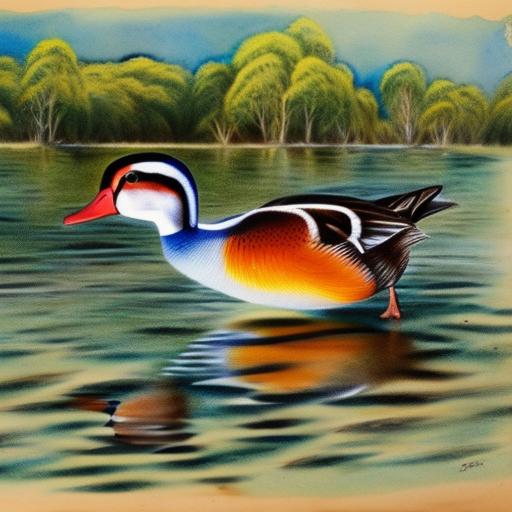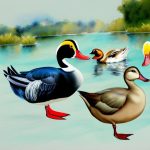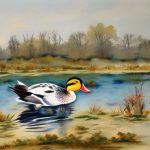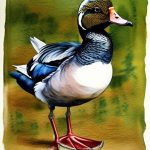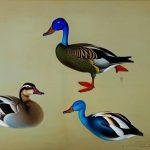Australian native duck breeds are a diverse group of waterfowl that have been an integral part of the country’s ecosystem for centuries. These ducks are well adapted to the Australian environment and have played a significant role in the lives of Indigenous Australians for food, cultural, and ceremonial purposes. The native duck breeds of Australia are known for their resilience, adaptability, and unique characteristics that set them apart from other duck breeds around the world.
The Australian environment is home to a variety of habitats, including wetlands, rivers, lakes, and coastal areas, which provide the perfect conditions for native duck breeds to thrive. These ducks have evolved to survive in diverse environments and have developed unique traits that make them well-suited to the Australian landscape. From the iconic Pacific Black Duck to the lesser-known Freckled Duck, Australian native duck breeds are an important part of the country’s natural heritage and play a crucial role in maintaining the ecological balance of their habitats.
Key Takeaways
- Australian native duck breeds are an important part of the country’s biodiversity and have unique characteristics and physical appearances.
- Some popular Australian native duck breeds include the Pacific Black Duck, the Australian Wood Duck, and the Freckled Duck.
- Breeding and rearing Australian native duck breeds require proper knowledge and care to ensure their health and well-being.
- Australian native duck breeds have various uses and benefits, including pest control, egg production, and meat consumption.
- Conservation and preservation efforts are crucial to protect and maintain the population of Australian native duck breeds for future generations.
Characteristics and Physical Appearance of Australian Native Duck Breeds
Australian native duck breeds exhibit a wide range of physical characteristics and appearances, reflecting their adaptation to different environments across the country. The Pacific Black Duck, for example, is a medium-sized duck with predominantly dark plumage, a distinctive pale stripe running from the bill to the eye, and a striking glossy green patch on its wing. In contrast, the Freckled Duck is a larger, more robust species with a mottled brown plumage, a prominent white eye-ring, and a unique bill shape that sets it apart from other duck breeds.
These native duck breeds have also developed specialized features to help them survive in their respective habitats. For instance, the Australian Wood Duck has a distinctive call and is known for its preference for nesting in tree hollows, while the Pink-eared Duck has a unique filtering system in its bill that allows it to feed on tiny aquatic organisms. These physical adaptations reflect the diversity and resilience of Australian native duck breeds and highlight their importance in maintaining the health and balance of their ecosystems.
Popular Australian Native Duck Breeds
Among the many native duck breeds found in Australia, several have gained popularity both within the country and internationally. The Pacific Black Duck is perhaps the most well-known and widely distributed native duck breed in Australia. Its adaptability to various habitats, striking appearance, and distinctive call make it a favorite among birdwatchers and conservationists alike. Another popular native duck breed is the Australian Wood Duck, which is often seen in urban parks and gardens, as well as in its natural wetland habitats.
The Freckled Duck, despite being less well-known, has also gained recognition for its unique appearance and behavior. This species is considered a conservation priority due to its declining population and is closely monitored by wildlife authorities and conservation organizations. Additionally, the Pink-eared Duck, with its distinctive pink patch behind the eye, has attracted attention from bird enthusiasts and researchers for its specialized feeding habits and social behavior. These popular native duck breeds are not only important for their ecological roles but also contribute to the cultural and recreational value of Australia’s natural heritage.
Breeding and Rearing Australian Native Duck Breeds
Breeding and rearing Australian native duck breeds require careful consideration of their specific habitat requirements, dietary needs, and reproductive behaviors. Many native duck breeds are migratory or nomadic, making it essential to provide suitable nesting sites and breeding grounds to support their populations. Conservation efforts often focus on creating and maintaining wetland habitats that are conducive to breeding and rearing native duck species.
In captivity, breeding and rearing native duck breeds require specialized knowledge and facilities to ensure the health and welfare of the ducks. Providing appropriate nesting materials, access to water for swimming and foraging, and a balanced diet are essential for successful breeding and rearing programs. Additionally, genetic diversity and disease management are important considerations in captive breeding programs to maintain the resilience and adaptability of native duck populations.
Uses and Benefits of Australian Native Duck Breeds
Australian native duck breeds have been utilized by Indigenous Australians for food, cultural ceremonies, and traditional crafts for thousands of years. The ducks provide a valuable source of protein and essential nutrients, contributing to the sustenance and well-being of Indigenous communities. In addition to their cultural significance, native duck breeds also play a crucial role in maintaining the ecological balance of wetland ecosystems by controlling insect populations, dispersing seeds, and contributing to nutrient cycling.
Furthermore, native duck breeds have become popular subjects for birdwatching, ecotourism, and wildlife photography, attracting visitors from around the world to observe these unique waterfowl in their natural habitats. The presence of native duck species in wetlands and other natural areas also contributes to the overall biodiversity and aesthetic value of these environments. Additionally, native ducks play a role in scientific research and education, providing valuable insights into avian behavior, ecology, and conservation.
Conservation and Preservation Efforts for Australian Native Duck Breeds

Conservation and preservation efforts for Australian native duck breeds are essential to ensure the survival of these iconic waterfowl species. Habitat loss, pollution, climate change, hunting pressure, and invasive species pose significant threats to native duck populations across Australia. Conservation organizations, government agencies, Indigenous groups, and local communities are working together to protect and restore wetland habitats, implement sustainable management practices, and raise awareness about the importance of native duck conservation.
In addition to habitat conservation, captive breeding programs play a crucial role in safeguarding the genetic diversity of native duck breeds and providing a safety net against population declines. These programs often collaborate with zoos, wildlife sanctuaries, research institutions, and government agencies to coordinate breeding efforts and release captive-bred ducks into suitable habitats. Furthermore, public engagement through citizen science initiatives, educational programs, and community-based conservation projects helps foster a sense of stewardship and appreciation for Australian native duck breeds.
Conclusion and Future Outlook for Australian Native Duck Breeds
Australian native duck breeds are an integral part of the country’s natural heritage and play a vital role in maintaining the health and balance of wetland ecosystems. As stewards of these unique waterfowl species, it is essential to continue efforts to conserve their habitats, protect their populations, and promote sustainable management practices. By raising awareness about the ecological importance and cultural significance of native duck breeds, we can inspire future generations to appreciate and support their conservation.
Looking ahead, the future outlook for Australian native duck breeds depends on our collective commitment to preserving their habitats, addressing threats to their survival, and promoting coexistence with human activities. Through collaborative conservation initiatives, research advancements, and community engagement, we can ensure that these iconic waterfowl species continue to thrive in Australia’s diverse landscapes for generations to come. By valuing and protecting our native duck breeds, we can contribute to the overall health and resilience of Australia’s natural environment while celebrating the unique beauty and diversity of these remarkable waterfowl.
If you’re interested in learning more about Australian native duck breeds, you might also want to check out this informative article on when duck mating season occurs. Understanding the mating habits of ducks can be crucial for successful breeding and raising of these beautiful birds.
FAQs
What are some native duck breeds in Australia?
Some native duck breeds in Australia include the Pacific Black Duck, the Australian Wood Duck, the Grey Teal, and the Chestnut Teal.
What are the characteristics of Australian native duck breeds?
Australian native duck breeds are typically medium-sized with a streamlined body, a slightly upturned bill, and webbed feet. They often have colorful plumage and are well adapted to the Australian environment.
What is the habitat of Australian native duck breeds?
Australian native duck breeds can be found in a variety of habitats including wetlands, rivers, lakes, and coastal areas. They are well adapted to both freshwater and saltwater environments.
What do Australian native duck breeds eat?
Australian native duck breeds are omnivorous and feed on a variety of foods including aquatic plants, insects, small fish, and crustaceans. They may also graze on grasses and grains.
Are Australian native duck breeds protected?
Many Australian native duck breeds are protected under wildlife conservation laws. It is important to check local regulations before hunting or keeping native duck breeds.
Can Australian native duck breeds be kept as pets?
Australian native duck breeds can be kept as pets with the proper permits and facilities. It is important to provide a suitable environment and diet for these ducks if kept in captivity.
Meet Walter, the feathered-friend fanatic of Florida! Nestled in the sunshine state, Walter struts through life with his feathered companions, clucking his way to happiness. With a coop that’s fancier than a five-star hotel, he’s the Don Juan of the chicken world. When he’s not teaching his hens to do the cha-cha, you’ll find him in a heated debate with his prized rooster, Sir Clucks-a-Lot. Walter’s poultry passion is no yolk; he’s the sunny-side-up guy you never knew you needed in your flock of friends!

